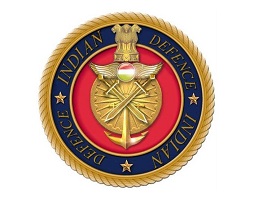1. Eligibility Criteria:
Age criteria:
The age of the candidate must be between 16½ years & 19½ years. Kindly note that the age limit is counting on the date of joining not the date of release of the NDA notification.
Educational qualification:
The candidates must have passed 10+2 board education from any state board & central board recognised school or college.
Note: - Candidates who are studying in 12th & going to appear in the board exam are also eligible to appear in the NDA exam.
Marital Status & Gender – Only unmarried & male candidates are eligible to appear in the NDA exam. Girls are not eligible to appear in this NDA exam.
2. NDA Selection Procedure
In order to get selected in the NDA/NA exam, candidates are required to go through the following NDA selection process and obtain favourable scores in each of them to achieve the desired post.
• Stage I: Written Examination
• Stage II: SSB Interview
• Stage III: Medical Test
• Stage IV: Final Merit
NDA Exam Pattern
The written examination under NDA qualifying in nature hence marks obtained in this test would be considered for the final selection. Go through the detailed NDA exam pattern below:
| Exam | Section | Questions | Marks | Time Allotted |
| Paper
I | Mathematics | 120 | 300 | 2.5 hrs |
| Paper
II | General
Ability Test | 150 | 600 | 2.5 hrs |
Following are the marks allotted to various sub-sections of the General Ability Test:
| Sections of General Ability Test | Weightage |
| English | 200
Marks |
| Physics | 100
Marks |
| Chemistry | 60
Marks |
| General
Science | 40
Marks |
| History | 80
Marks |
| Geography | 80
Marks |
| Current
Affairs | 40
Marks |
Note: There will be negative marking for each question that is incorrectly attempted. One-third of the marks that are assigned to that question will be deducted for an incorrect response. So make sure you only answer what you are sure of.
3. NDA/NA Syllabus
Below is the detailed subject-wise syllabus of the NDA/NA Examination:
Syllabus of Mathematics Section
| Name of Topic | Subtopics |
| Algebra | Set concept, sets operations, Venn
diagrams. Laws of De Morgan, Cartesian product, the relationship of equivalence.
Real number representation on a line. Complex numbers – basic properties,
module, argument, unity cube roots. Binary number system. Conversion to the binary system of a
number in the decimal system and vice versa. Progressions in arithmetic, geometry
and harmony. Real-coefficient quadratic equations. The solution of linear inequations of two variables by graphs. Permutation and Combination. Binomial theorem and its applications Logarithms
and their applications. |
| Matrices and Determinants | Matrix
types, matrix operations. The determinant of a matrix, determinant’s properties. Application-Solution of a system
of linear equations in two or three unknowns by the Cranmer’s Rule and by the
Matrix method. |
| Trigonometry | Angles and their degree and
measurements. Trigonometric ratios. Sum of trigonometric identities and
formulas. Multiple angles and sub-multiples. Trigonometric functions & their
inverse. Applications-Height and Distance, Triangle
Properties. |
| Analytical geometry of two and three dimensions | The
Cartesian Rectangular Coordinate System Formula of distance. Equation of a line
in different shapes. Two lines of angle. A point’s distance from a line standard
and general equation of a circle. Parabola, ellipse and hyperbola are standard
forms. A conic’s eccentricity and axis. Point the distance between two points
in a three-dimensional space. Cosines of direction and ratios of direction. Two
points of the equation. Cosines of direction and ratios of direction. A plane
equation and a line in different forms. Two lines of the angle between two planes.
Sphere’s equation. |
| Differential calculus | Concept of valued function-a
function’s domain, range and graph. Composite functions, one by one, on and
vice versa. Limit notion, default limits – examples. Continuity of functions-
examples, continuous functional algebraic operations. Function derivative at a point,
geometric and physical interpretation of an application derivative. Summary derivatives, product and
function quotient derivatives function derivatives for another function, 20
composite function derivatives. Derivatives of the second order.
Increasing and diminishing functions. Application of derivatives in maxima and minima
problems. |
| Integral calculus and Differential equations | Differentiation and integration,
standard integrals with algebraic expressions, trigonometric, exponential and
hyperbolic functions. Definite integrals – determination of areas of curved
plane regions – applications. General and particular solution of differential
equations, solution of the first order and first–degree differential
equations of various types – examples. Application in problems of growth and decay. |
| Vector Algebra | Two-and
three-dimensional vectors, vector magnitude and direction. Unit and null
vectors, vector adding, scalar-vector multiplication, Scalar product or dot
product. Vector product or cross product. Applications- work done through force
and moment of force and in geometric problems. |
| Statistics And Probability | Statistics: data classification,
distribution of frequencies, the cumulative distribution of frequencies-
examples. Examples of graphic representation- histogram,
pie chart, polygon frequency. Central tendency measurements- mean, median, and
mode. Variance and deviation of standard – determination and comparison.
Correlation and regression sample space, events, exhaustive events &
mutually exclusive, impossible and certain events associated with random
experiments, result and associated. Union and events intersection.
Complementary, composite and elementary events. Probability definition-
classical and statistical- examples. Elementary probability theorems- simple
issues. The conditional likelihood, the theorem of Bayes- simple problems
Random variable on a sample space as a function. Binomial distribution,
examples of random experiments, the binomial distribution. |
Syllabus of English Section for NDA/NA Exam
• Grammar & usage
• Comprehension & cohesion
• Spotting of errors
• Para Jumbling
• Fill in the blanks
• Synonyms & Antonyms
• Vocabulary
• Cloze Test
• Idioms & Proverbs
• Completion of Sentence & Para
• Sentence Correction & Improvement
Syllabus of General Mental Ability Section for NDA/NA Exam
| Name of the Topic | Subtopics |
| English | • Vocabulary • Grammar & Usage |
| Physics | Matter
and its properties (mass, weight etc) and specific gravity, Archimedes
principle, Motion, Velocity and Acceleration, Newton’s Laws of Motion, Force
and Momentum, Force Parallelogram, Stability and Body Equilibrium, Gravity,
Elementary work ideas, Power and Energy. Heat effects, temperature and heat
measurement, state change and latent heat, heat transfer modes. Rectilinear
light, reflection and refraction propagation. Spherical mirrors and human eye
lenses. Natural and artificial magnets, a magnet’s properties, earth as a
magnet. Electricity, Ohm’s law, conductors and non-conductors, Simple
Electrical Circuits, Current Heating, Lighting and Magnetic effects, Electrical
Power Measurement, Primary and Secondary cells, X-Ray use. Simple Pendulum,
Simple Pulleys, Telegraph, Telephone, Periscope, Telescope, Siphon, Levers,
Balloon, Pumps, Hydrometer, Pressure Cooker, Thermos Flask, Gramophone,
Microscope, Mariner’s Compass. |
| Chemistry | Changes in Physical and Chemical
conditions. Chemical combination law. Air and water properties. Hydrogen,
Oxygen, Nitrogen and Carbon Dioxide preparation and properties, Oxidation and Reduction.
Acids, bases, salts, etc. Carbon – Various forms. Fertilizers- Artificial
and Natural. The material used in the preparation of
substances such as Soap, Glass, Ink, Paper, Cement, Paints, Gunpowder and Safety
Matches. Basic ideas on Atom Atomic equivalent and molecular weights structure,
Valence. |
| General Science | Living
and non-living difference. Life basis – cells, protoplasm’s, tissues. Plant and
animal growth and reproduction. Human Body’s basic knowledge and its important
organs. Common epidemics causes and prevention of them. Food – man’s energy
source. Food constituents, balanced diet. The Meteors and Comets Solar System.
Eclipses. Eminent Scientist’s achievements. |
| History | A comprehensive survey of Indian History, focusing on culture and civilization.
Freedom movement. Indian Constitution and administration elementary study. The
basic knowledge of India’s five-year plans. Panchayat Raj, community
development co-operatives. Bhoodan, Sarvodaya, Mahatma Gandhi’s basic
teachings, National integration and welfare state. Modern world forces;
Renaissance, Exploration and discovery; American Independence war. French
Revolution, Russian Revolution and the Industrial Revolution. Impact on society
of science and technology. One world concept, UN, Panchsheel, Democracy, Socialism
and Communism. India’s role in today’s world. |
| Geography | The shape and size of the Earth.
Latitudes, Longitudes, Time Concept. DateLine International. Earth’s
movements and effects. Earth’s origin. Rocks and their classification;
mechanical and chemical weathering, earthquakes and volcanoes. Ocean currents
and tides atmosphere and their composition; Temperature and Atmospheric
pressure, Planetary winds, Cyclones and anti- cyclones; Humidity; Condensation
23 and Precipitation; Climate types, World’s major natural regions.
India’s regional geography- climate, natural vegetation. Resources for minerals
and power; location and distribution of agricultural and Industrial activities.
Important seaports and major seaports, land and air routes. |
| Current Events | Knowledge
of major events that have occurred in India over the past few years. Current
major events in the world. Important personalities around the world including
those related to cultural and sports activities. |





Contrary to popular belief, Lorem Ipsum is not simply random text. It has roots in a piece of classical Latin literature College in Virginia ?
It is a long established fact that a reader will be distracted by the readable content of a page when looking at its layout. The point of using Lorem Ipsum.